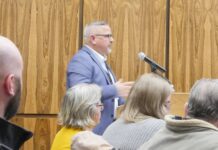HARVEYS LAKE — A recently acquired grant will further eradicate hydrilla from Harveys Lake, Michell’e Boice, a Harveys Lake Borough member said Tuesday.
Hydrilla, an aggressive growing aquatic plant, took root in the lake in 2014 and quickly infected 250 acres of the 600-acre lake in three years, said Fred Lubnow, the director of aquatic programs at Princeton Hydro, an ecological and engineering consulting service.
“This is a costly thing (removing hydrilla) to do,” Boice said, adding the municipality “definitely needs (financial) help with this.”
The $208,870 Growing Greener grant from the state Department of Environmental Protection will fund a second treatment in May or June 2018, Lubnow said.
The borough council acquired over $100,000 in grant funding from the Department of Environmental Protection’s Clean Water program. Princeton Hydro applied 2,180 pounds of SonarOne, a clay-based herbicide, to a 105-acre section in August.
This fall, Lubnow reviewed the treated area and found the hydrilla had turned white and was dying off.
If left untreated, hydrilla will grow to the water’s surface and create a thick green mat, which prevents sunlight from reaching native plants, fish and other organisms. The lack of sunlight chokes out all aquatic life.
Hydrilla’s ability to reproduce is like blowing on a dandelion seed-head; seeds float away and take root somewhere else, council member Bill Hilburt said in an interview in August.
Broken pieces of hydrilla can reroot in another place in the lake or any tributary, such as the Susquehanna River, which flows into the Chesapeake Bay, Boice said.
“I believe that is why we are on the radar for some of these grants,” Boice said. “Harveys Lake is the largest lake by water volume in the state and it affects the Susquehanna River and Chesapeake Bay area.”
Lubnow plans to schedule a meeting with council members and SePRO, the manufacture of SonarOne, to determine the best version and application method to efficiently treat the lake.
“The original idea was to treat one big area,” Lubnow said. “There are different forms of SonarOne. There are slow-releasing forms, liquid and a quick-release version.”
SonarOne blocks hydrilla’s ability to produce chloroplast, which aids the photosynthesis process where chlorophyll is made from sunlight.
The low-concentration chemical will not harm fish, ducks or people using the lake, but residents are advised to not use lake water for irrigation purposes.
Lubnow estimates complete eradication of the aquatic plant could take three to five years, but boaters and lake users must be vigilant and remove all vegetation from the bottom of watercrafts and trailers to prevent re-infection.




